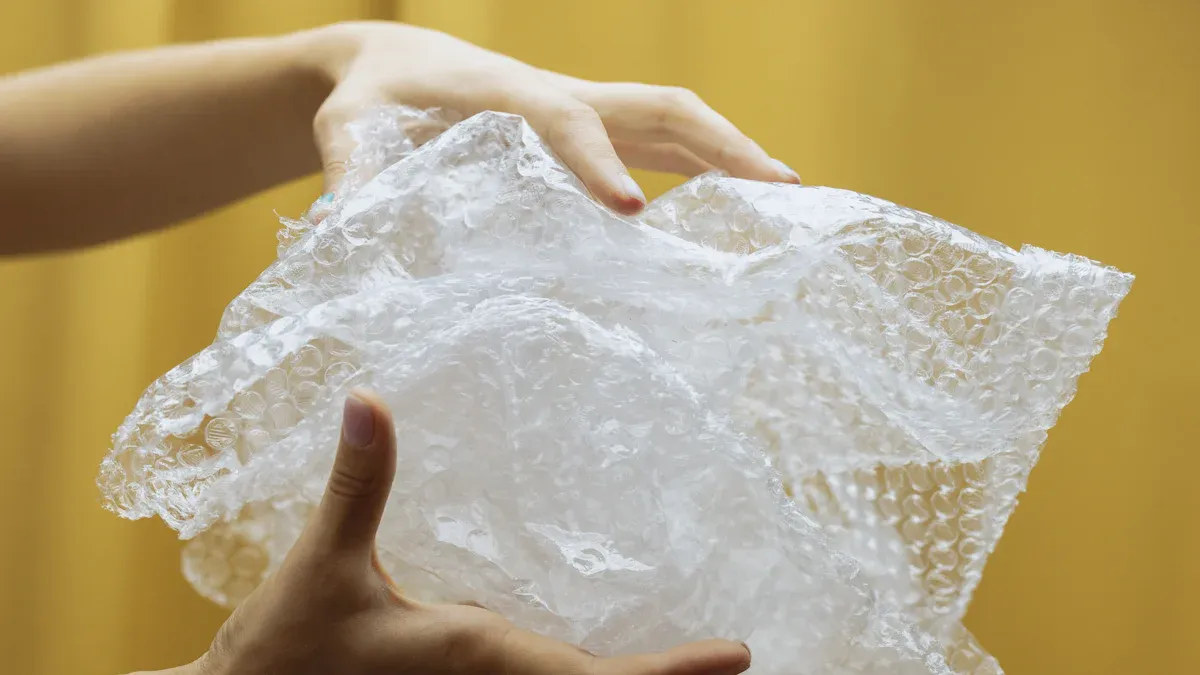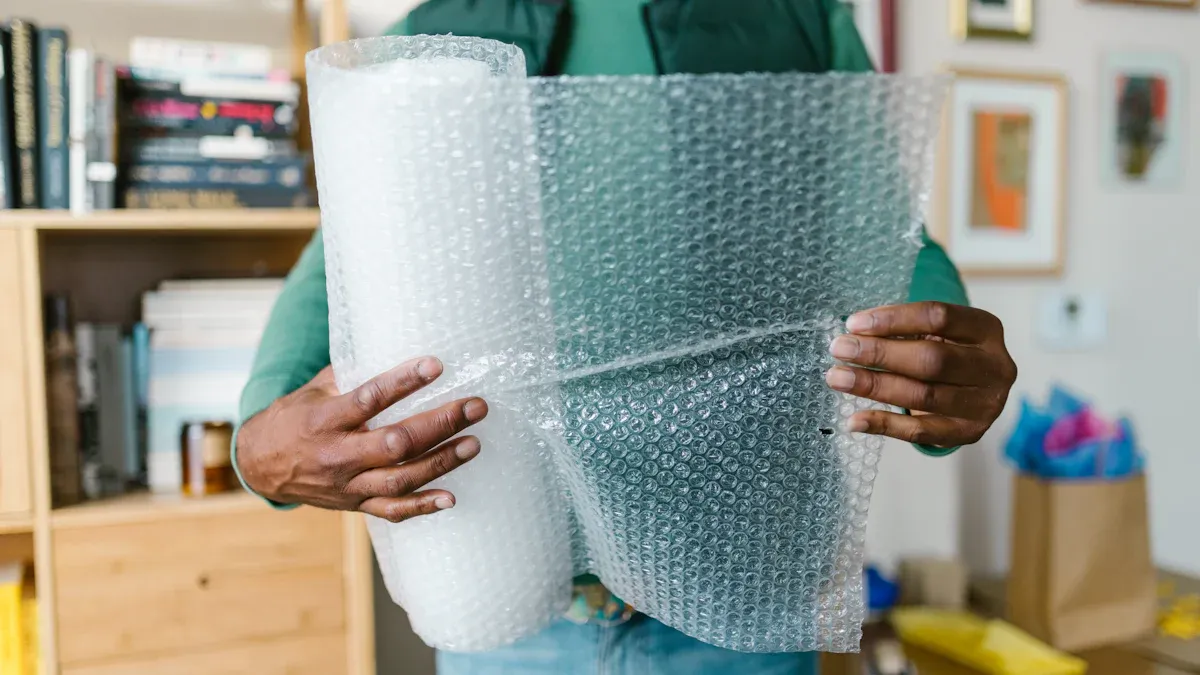Essential Protective Packaging for Fragile International Shipments

When you ship fragile items to other countries, essential protective packaging is crucial. Glassware, artwork, electronics, and mirrors can easily get damaged during shipping. If you do not use the right packing, these items can break or crack, potentially arriving damaged. Almost one out of three returns occur because packaging does not adequately protect items. Utilizing essential protective packaging keeps your fragile belongings safe, helping you avoid issues and providing peace of mind. If you’re looking for easy packaging tips, you’re in the right place. You can make every shipment safer and feel more confident.
Key Takeaways
Use strong boxes that are the right size to stop things from moving and breaking during shipping. Wrap each fragile item by itself with bubble wrap or foam to keep it safe. Fill all empty spots in the box with packing peanuts or crumpled paper so nothing shifts. Put clear labels on packages with 'Fragile' and 'This Side Up' to help people handle them carefully. Think about getting insurance for valuable things to protect them if they get lost or broken while being shipped.
Why Essential Protective Packaging Matters
Risks for Fragile Items in International Shipping
Sending fragile items to other countries can be risky. Packages go through busy places and ride on trucks. Many people handle them along the way. Each step can hurt your fragile things. Bumps and drops can damage corners or break small parts. If you use boxes that are too big or not enough padding, things can break.
Here’s a quick look at the main causes of damage:
Cause of Damage | Description |
|---|---|
Impact During Handling | Items can get damaged from bumps and drops, especially at corners, edges, and fragile parts. |
Inadequate Packaging | Using boxes that are too big or not enough padding can cause damage during shipping. |
Do not use thin boxes or regular fillers. These do not keep fragile things safe. If you do not match the packaging to how breakable the item is, you might lose money and upset your customers. Bubble wrap and strong boxes help protect fragile things.
Benefits of Proper Packaging
Choosing the right packaging for fragile things helps a lot. Good packing keeps items from moving around. This means less damage and better chances your things arrive safely.
Let’s see how proper packaging helps you:
Benefit | Description |
|---|---|
Minimizes Damage | Good packaging keeps fragile things safe and stops them from moving, so there is less damage. |
Improves Customer Satisfaction | When things arrive safely, customers are happier. |
Enhances Brand Reputation | Sending items without damage makes your brand look good. |
You save money because you do not need to replace broken things.
Customers are happy when their fragile items are safe.
Your brand gets more trust when shipping is reliable.
Bubble wrap is great for fragile things. It stops bumps, keeps away scratches, and protects items during shipping. It is light, so it helps lower shipping costs. Using good packing makes sure your fragile things get to their new home safely.
Tip: Always use packaging that fits your fragile items. Double layers give extra safety for breakable things.
Essential Protective Packaging Materials
Choosing the Right Box for Fragile Products
Picking the right box is important. The box should fit your fragile item’s size and weight. If the box is too big, things can move and break. If the box is too small, there is not enough room for padding.
Here’s a simple guide to box strength:
Type of Box | Layers | Best For | Strength |
|---|---|---|---|
Single Wall Boxes | 1 | Lightweight items | Good |
Double Wall Boxes | 2 | Medium-weight items | Better |
Triple Wall Boxes | 3 | Heavy or fragile items | Best |
Triple wall boxes protect fragile things the most. Always look for damage on the box before you pack.
Cushioning Materials: Bubble Wrap, Foam, and Peanuts
Cushioning keeps fragile things safe when shipping. You should wrap your items with good packing materials. Bubble wrap is popular for fragile things. The bubbles help stop bumps and protect glassware and electronics. Foam sheets stop scratches and add soft padding. Packing peanuts fill spaces and keep things from moving.
Here’s how these packing materials help:
Bubble wrap protects fragile things from bumps.
Foam sheets stop scratches and add soft padding.
Air pillows fill spaces and do not add much weight.
Custom foam inserts work for delicate or odd-shaped items.
Packing peanuts keep things steady and stop shifting.
Bubble wrap and peanuts together give more protection.
Tip: Use enough bubble wrap and foam to cover every side. More layers mean your fragile things are safer.
Eco-Friendly and Custom Packaging Options
You can keep fragile things safe and help the planet. Many eco-friendly packing materials work well. Try these options:
Paper and cardboard packaging: You can recycle these and they come from plants.
Compostable mailers: They break down into soil after use.
Cornstarch packaging: It is light and breaks down easily.
Mushroom packaging: It grows from farm waste and is compostable.
Cellulose packaging: You can recycle it and it is better than plastic.
Green cell foam: It breaks down and cushions fragile things.
Custom packaging fits your fragile things perfectly. It saves space and gives the best protection. Using the right protective packaging helps your fragile items arrive safely.
Cushioning and Padding Techniques for Fragile Items

When you send fragile items overseas, you want them to arrive in perfect shape. The right cushioning and padding techniques make all the difference. Let’s look at the best ways to wrap, layer, and double box your valuables for maximum protection.
Wrapping and Layering Methods
You need to wrap each item with care. Start by choosing soft materials like packing paper, foam, or bubble wrap. These materials create a barrier that absorbs shocks and keeps your fragile items safe. Here’s how you can do it:
Pad the bottom of your box with a thick layer of packing materials. This base layer acts like a cushion for your fragile items.
Wrap each item individually. Use at least three inches of bubble wrap or foam around every piece. For very fragile things like glassware or ceramics, use even thicker wrapping.
Secure the wrap with tape so it stays in place.
For plates, stand them up vertically and wrap each one. This position helps prevent breakage.
Use dividers for glasses and stemware. These keep items from bumping into each other.
Add extra wrap to corners and edges. These spots are most likely to get damaged during shipping.
Place heavier items at the bottom of the box and lighter ones on top. This keeps everything stable.
Fill all empty spaces with packing peanuts or crumpled paper. This step stops items from shifting inside the box.
Separate layers of items with more padding. If you have several fragile items, add a layer of wrap or foam between each one.
Make sure every item sits in the center of the box, surrounded by cushioning on all sides.
Tip: The more layers you wrap around your fragile items, the better the protection. Multiple layers absorb shocks and impacts, keeping your valuables secure.
You should always wrap each item by itself. This method gives every piece its own cushion and lowers the risk of damage. If you use enough wrap and padding, your fragile items will stay safe, even if the box gets bumped or dropped.
Double Boxing for Extra Protection
Sometimes, one box just isn’t enough. If you’re shipping high-value or extremely fragile items, double boxing gives you an extra layer of protection. Here’s how you can do it:
First, wrap your item with bubble wrap or foam. Make sure you cover every part, especially the corners and edges.
Place the wrapped item in a small, sturdy box. Fill any gaps with packing peanuts or more wrap so the item doesn’t move.
Seal the inner box with strong tape.
Next, get a larger box. Line the bottom with more packing material.
Put the smaller box inside the larger one. Fill all the space around it with extra wrap, foam, or peanuts.
Seal the outer box tightly.
The double-box method works like a shield. If the outer box gets hit or crushed, the inner box and all the wrap inside absorb the impact. Professionals use this method for glassware and other delicate items because it adds two layers of protection. You can lower the risk of damage and avoid costly returns by double boxing your fragile items.
Note: Always choose boxes that are strong enough to support the weight of your items. Weak boxes can collapse, even with good wrap and padding.
When you use these wrapping and double boxing techniques, you give your fragile items the best chance of arriving safely. Good packing and smart protection keep your valuables secure from start to finish.
Sealing, Reinforcing, and Labeling
When you send fragile things to other countries, sealing and making boxes stronger is very important. Doing this the right way helps your package get there safely.
Best Practices for Sealing Packages
You want your box to stay shut, even if it gets tossed around. Using strong tape and sealing it well is important. Here is a simple guide to help you:
Practice | Description |
|---|---|
This tape comes in different sizes and is strong. | |
Utilize side load dispensers | Tape guns help you put tape on fast and easy. |
Secure and seal the box | Good tape keeps the box closed tight. |
Use high-quality packing tape | Strong tape works well for long trips. |
Seal all openings and seams | Put extra tape on for more safety. |
Tip: Always put tape on every seam and opening. Check the top and bottom of the box before you send it.
Reinforcement for Weak Points
Some parts of your box are weaker than others. Corners, edges, and seams can break more easily. Try these ways to make your box stronger:
Packing tape: Use strong tape for extra hold.
Stretchwrap: Wrap plastic film around the box to keep it tight.
Strapping: Use bands to hold your box together.
Corner protectors: Add these to stop corners from getting crushed.
Edge guards: Protect the sides from pressure.
Cardboard inserts: Put these inside to help the box keep its shape.
Inner frames: Build a frame inside for more strength.
Padding layers: Add more padding to soak up bumps.
Note: Making your box stronger helps keep fragile things safe from drops and bumps.
Labeling Fragile Shipments
Clear labels tell people to be careful with your package. Use bright stickers that are easy to read. Follow these tips:
Source | Key Recommendations |
|---|---|
Supplies Shops | Use clear handling instructions that follow rules. |
iContainers | Add words like 'This Side Up', 'Fragile', and 'Non-stackable' in different languages. |
Noissue | Put on more than one sticker, but do not cover the shipping label. |
Tip: Put labels on more than one side of the box. This way, people see them no matter how the box sits.
If you seal, reinforce, and label your box the right way, your fragile things have a better chance to arrive safely. Good packing, strong tape, and clear labels help keep your items safe.
Fishgoo Value-Added Packaging Services
If you send fragile things to other countries, you want them to arrive safely. Fishgoo’s packaging services help you feel calm. You can pick from different choices when you send your package. This makes it easy to find the right protection for your stuff.
Reinforced Outer Box and Shockproof Packaging
Fishgoo’s packaging services use strong boxes and shockproof packing. These choices help keep fragile things safe, even if the box gets bumped. You get tough materials like corrugated cardboard, foam, and bubble wrap. Fishgoo’s boxes have extra strong corners and edges. This gives your fragile things more protection.
Aspect | Details |
|---|---|
Material Selection | Strong cardboard, foam, and bubble wrap for fragile item protection |
Cushioning Techniques | Foam and air pillows absorb shocks |
Sealing Methods | Robust sealing keeps boxes tightly closed |
You can also choose boxes that fit your items. This stops fragile things from moving around. Fishgoo’s packaging uses trusted methods, so your things are safe.
Waterproof and Vacuum Packaging Options
Water can hurt fragile things when shipping. Fishgoo’s packaging services offer waterproof and vacuum packing to keep your items dry. Waterproof packing adds a layer that blocks water and humidity. Vacuum packing takes out air. This helps protect fragile things from moisture, air, and temperature changes.
Vacuum sealing makes packages smaller and lowers shipping costs.
It keeps fragile things safe from water and dirt.
Waterproof packing is good for electronics, collectibles, and things that must stay dry.
You can pick these packaging services when you send your package. Just choose the options that work for you.
Simple Packaging and When to Use It
Sometimes, you do not need strong protection. Fishgoo’s packaging services also have simple packing. This is best for soft things like clothes or items that are not fragile. Simple packing uses light materials to save money on shipping.
Tip: Only use simple packing if your things are not fragile and follow the platform’s rules.
Fishgoo’s packaging services make it easy to keep fragile things safe. You can pick the best packing for every package. Your items arrive safely, and you feel sure every time.
Shipping Logistics and Insurance for Fragile Products
Choosing a Reliable Carrier
Picking the right carrier is very important. Some shipping companies do not handle fragile things carefully. You need a carrier that knows how to move breakable items safely. Look for these things:
Avoid companies known for rough handling.
Put clear labels like “Fragile” and “Handle With Care” on your box.
Use symbols such as “This Way Up” or “Keep Dry” so workers know what to do.
Add warning labels and stencils to show your package needs special care.
A good carrier helps your fragile items arrive safely.
Insurance and Tracking for Fragile Shipments
Insurance helps you feel calm when you send valuable things. If you ship glassware, electronics, or jewelry, insurance is smart. Here is why:
Insurance pays if your fragile items get lost or broken.
It is extra important for expensive or easy-to-break things.
Shipping to other countries can be risky, so insurance helps protect you.
Most carriers let you track your package. You can see where your box is as it travels. If something goes wrong, you will know quickly.
Tip: Always check what your insurance covers before you ship. Some plans only pay for certain damage.
Compliance with International Shipping Rules
Every country has its own shipping rules. You must follow these rules to avoid problems. Remember these steps:
Fill out all customs forms the right way.
List what is inside your box and its value.
Check if your fragile items need special papers or certificates.
Make sure your packaging follows each country’s rules.
If you do these things, your fragile shipment will go through customs easily. Good packing, the right carrier, and correct paperwork make shipping fragile products simple.
Common Mistakes to Avoid with Fragile Items
When you send fragile things to other countries, small mistakes can cause big trouble. Let’s see what mistakes happen most and how you can stop them.
Insufficient Cushioning or Padding
Not using enough padding is a main reason fragile things break. Some people think a little bubble wrap is enough, but it is not. You must fill every empty space in the box. If you leave gaps, things can move and hit the sides. This is when cracks and chips happen.
Always wrap each thing with soft padding like bubble wrap or foam.
Add more layers for very delicate things.
Fill the bottom, sides, and top with packing peanuts or crumpled paper.
Make sure nothing moves when you gently shake the box.
Tip: More padding means less chance of breaking. Use extra materials to keep things safe.
Using Inappropriate Packaging Materials
Picking the wrong materials can ruin your shipment. Weak boxes can break if something heavy is on top. Thin or bad packaging does not protect your things. Some people forget about static electricity, which can hurt electronics.
The right box size is important too. If the box is too big, things can slide around. If it is too small, there is no room for padding. Always use strong boxes and good materials. This helps protect your things from bumps and shakes during shipping.
Overlooking Labeling and Documentation
You might pack your things well, but if you forget labels, handlers will not know to be careful. Labels like “Fragile,” “This Side Up,” or “Handle With Care” tell people your box needs special care.
Use clear, easy-to-read labels on every side of the box.
Add instructions in more than one language if you can.
Make sure all customs forms and papers are filled out.
Note: Good labels and paperwork help your fragile things arrive safely and on time.
If you avoid these mistakes, your fragile things have a better chance to get there in perfect shape.
You want your fragile items to arrive safely. Start by choosing the right packaging and packing materials. Use bubble wrap, foam inserts, and sturdy boxes. Fill every gap and seal the box well. Here’s a quick checklist to help you:
Step | What to Do |
|---|---|
1 | Pick strong packaging and custom boxes. |
2 | Add bubble wrap and packing peanuts for cushioning. |
3 | Seal and label your box for safe shipping. |
Fishgoo’s value-added services use expert techniques and insurance to make shipping stress-free. Try these tips and enjoy worry-free delivery every time.
FAQ
How do I choose the best packaging for fragile items?
Pick packaging that matches your item’s size and shape. Use strong boxes for better safety. Add enough padding to protect your things. Custom packing helps keep delicate items safe when shipping.
What packing materials work best for glassware?
Bubble wrap and foam sheets are good choices. Wrap each glass piece by itself. Fill empty spots with packing peanuts. This helps keep glassware safe during shipping.
Can I track my package during shipping?
Yes, you can track your package online. Most shipping companies give you a tracking number. You can see updates as your package moves.
Should I buy insurance for fragile shipments?
Insurance helps you worry less. If your fragile things break or get lost, insurance can pay you back. It is a good idea for valuable items.
What happens if my package arrives damaged?
Tell your shipping company right away. Take pictures of the damaged box and items. Keep all the packing materials. File a claim to get help or a refund.
See Also
Key Global Shipping Services Every Newbie Should Know
The Importance of International Warehousing for Business Growth
Reasons FISHGOO Stands Out as a Reliable Shipping Proxy
FISHGOO Offers Reliable Shipping Solutions for Weidian Purchases
Understanding International Freight Forwarding and Its Significance


